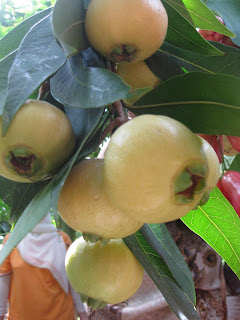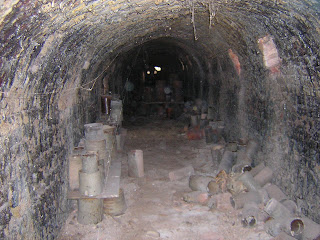 |
| Juicy round jambu mawar |
Gardeners say that talking to your plants will make them grow but at Desaru Fruit Farm, visitors learn that plants not only need some persuasion to bear fruit, they should also be stressed.
Henry Goh, the Farm General Manager, explained that fruit trees reluctant to bear fruit, will get its trunk whacked with a few strokes of the parang while persuasive words are whispered to stimulate it to flower and fruit. His larger-than-life persona and tri-lingual spiel, sprinkled with fascinating anecdotes and colloquial humour, held visitors’ rapt attention as they toured the farm with him.
City-slickers may enjoy wide varieties of tropical fruits but many haven’t the foggiest idea about how its tree or the uncut fruit looked like. If they are only used to seeing fruits in the supermarkets or on fruit platters, this will soon change as Goh takes them on a walk between fruit trees to look at fruits that are still on the trees.
With a strictly “No Picking” rule, visitors are welcome to see, smell, touch and feel the fruits while Goh selects ripe fruits and offers them, freshly cut for everyone to sample the juicy flavours under the trees.
 |
| Henry Goh [Left] cutting fresh dragon fruit for guests to sample |
When bunches of pulasan are offered, visitors are shown how to twist its thick, dark-red skins off to reach the juicy fruits inside. Guided around the farm, visitors get to sample fruits ranging from kedondong, guava, dragon fruit, passion fruit, custard apple and mango to an interesting variety of jambu like the round Jambu Mawar, Jambu Rose, Jambu King and Jambu Madu. Pointing to breadfruit or sukun on the tree, Goh assures visitors that they can have a taste of it, deliciously deep-fried, in the farm’s fruit buffet.
The farm often hosts visits with schoolchildren, corporate groups, families and foreign tourists and is also a favourite destination for most visitors to the Desaru resort district. As visitors tour the well-organized farm, little do they know that this award-winning farm started in the early 90’s as a humble fruit stall along the Desaru main road.
Visitors to Desaru would inevitably stop to buy fruits from this stall and it was such a popular stopover that cars parked haphazardly next to it became a potential traffic hazard. When the authorities advised the fruit stall to move into the safety of the adjacent land, this fruit business gradually developed into the Desaru Fruit Farm.
 |
| Freshly cut slice of juicy mango |
Since the farm opened its doors to visitors in 2001, its popularity increased by leaps and bounds and soon established itself as one of the nation’s largest Agro Tourism sites. Sprawled across 100 acres of land cultivated with more than 10 species of plants and more than 100 varieties of tropical seasonal and non-seasonal fruits, the farm operates with Good Agricultural Practice or GAP, to increase yields with a systematic organic and non-chemical fertilizer programme.
Visitors will notice a distinct absence of mosquitoes and irritating insects as they walk around because the farm is kept comfortably pest-free with a good drainage system, an intercropping system and the Integrated Pest Management [IPM] method. To protect against fruit flies, rotten fruits that dropped under the trees are consistently cleared away to process into organic compost. Goh said pruning bushy plants not only helps to enhance air circulation and protect against algae infection, it also encourages crosswind pollination.
 |
| Feeding goats, the farm's natural grass-cutters, in the barn |
In addition to fruit trees, the farm also has an Herb and Vegetable Garden
It’s interesting to learn that goats are such sensitive creatures that they refuse to taste another goat’s saliva. When feeding a goat, Goh said that you should give the whole vegetable stalk instead of holding a bunch of vegetables to let it chew a chunk off. If the half-bitten bunch of vegetables was offered to another goat, it will be wasted because the goat would only sniff but refuse to take a bite!
 |
| Chilled fruit juices are refreshing thirst quenchers |
The goats are also employed as natural grass-cutters because they graze around the farm and help to maintain the grass at neatly trimmed lengths. Goats are bred for meat and its dung is processed to produce Organic Bio Fertilizer [OBF]. OBF is made with pure organic materials specially blended with Effective Micro-organisms [EM] and used in the farm to enhance sustainable agriculture and improve the quality of the environment.
A fitting end to this entertaining and educational Farm Tour is to enjoy a refreshing and mouth-watering, all-you-can-eat fruit buffet. At any time of day, visitors can opt for the Farm Specialty tour that offers a buffet of more than 12 types of fresh and pickled fruits.
“The best way to enjoy your meal is to begin with fruits and end it with fruits,” advised the affable Goh as he invited visitors to enjoy the generous buffet lunch spread that included separate stations for freshly-made fruit juices, fried fruits, kampong lunch and traditional desserts and kueh made with farm-grown fruits and vegetables. A visit to the Farm is not complete without shopping for fresh fruits at the Souvenir Shop to enjoy at home and share with others.
 |
| Shopping for fresh fruits at Desaru Fruit Farm |
The Farm is the proud recipient of a host of Ministry of Agriculture national level awards including the Special Award MAHA, Agro-tourism category in 2006 and first Runner-up in Farmer’s Day Best Farm contest 2001. It is open daily from 9.00am to 6.00pm and advance group reservations for tours and meals are recommended.
Hourly guided tours for a minimum of 2 visitors, starts from 9.30am and the last tour is at 5.30pm. Alternative packages are Deluxe Tropical Fruit Fiesta, Outdoor Lunch and Fruit Fiesta and seasonal promotions like Durian Breakaway. For reservations, Tel: 07 – 822 5886, 822 3886 and Fax: 07 – 822 4886. Email: sales@desaruff.com or visit website: http://www.desaruff.com/
 |
| Guests helping themselves to the wide variety of fresh and pickled fruits in the fruit buffet at Desaru Fruit Farm |

































